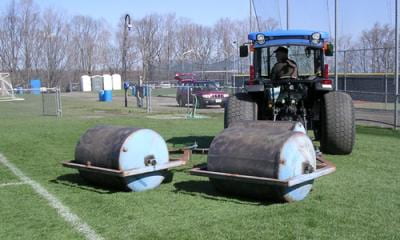
Rolling is used to smooth out uneven surfaces caused by heavy traffic and can be used to press uprooted or heaved plants back into the soil to prevent desiccation. Rolling can produce a firm surface to provide a “faster” surface. Like all field practices it must be done correctly so it won’t do more harm than good. If the soil is too dry there will be no response to the rolling and if the soil is too wet excessive soil compaction can occur.
Rollers typically range from 300-2000 pounds or more. The maximum weight which should be used for a native soil is one ton (2000#). The amount of stress a particular soil can withstand depends upon its ability to resist compaction which depends upon soil texture (sand or native soil) and moisture content. So make sure the roller is not too heavy for your situation or it can rut up and over compact the field.
Also, the need for rolling will depend on the specific situation and will vary from field to field. If rolling needs to be done, it should be done in 2 directions.
Facts and tips
Provided by Dave Minner, Turfgrass Extension Specialist, Iowa State University:
- Rolling does not improve turf quality. In fact, over use results in turf thinning and quality is significantly reduced.
- Soils that are wet and/or frozen are susceptible to surface compaction. Over use of rollers will also result in surface compaction. It is critical that rolled fields are regularly aerated.
- Soils that are too dry will not benefit from the impact of rolling. Furthermore, if the turf is wilted or dormant it will be severely stressed and may die. Rolling should only be carried out if grass is actively growing.
- Fields with 100% grass cover and a moderate thatch layer are less likely to be affected by rolling as a method to increase field “speed”.
- Never roll fields that have disease problems, particularly infectious diseases like gray leaf spot, pythium, or brown patch.
Rolling Frequency
The decision as to how often to roll a field should be made by the field manager and coach on a field-by-field basis. Factors to consider include: athlete safety and playability, soil moisture, recovery time and turf quality.
Remember, rolling should only be carried out “as-needed”, not routinely. This may be once per year in the spring (after winter soil heave) or several times during the playing season to keep the field safe and playable if grass cover is lost.
When rolling sports fields that are already prone to compaction remember to always counter-balanced rolling by conducting a strong aeration program.


